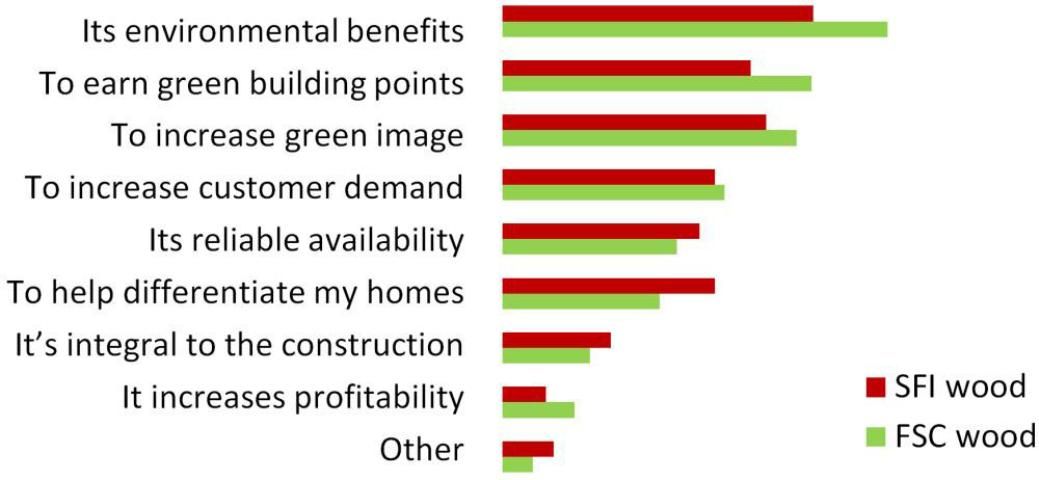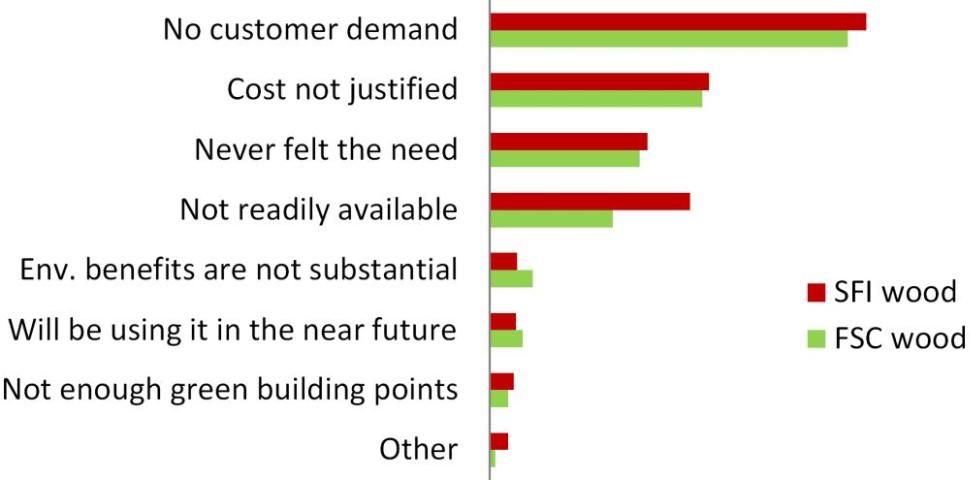This research was supported by Agriculture and Food Research Initiative Competitive Grant no. 2010-65400-20435 from the USDA National Institute of Food and Agriculture.
Quick Facts
- The information contained in this article is adapted from a study that employed a representative sample of US homebuilders (Ganguly, Eastin, Cantrell, & Bowers, 2012). The regional representation of that sample is closely aligned with the regional breakdown of US housing starting in 2010.
- The majority of users of wood certified by the Forest Stewardship Council (FSC) cite “green building points” as one of the major reasons for using ECWPs (Ganguly et al., 2012).
- Architects, a major specifier of ECWPs, are becoming more familiar with FCS and residential green building programs (RGBPs) (Bowers, Ganguly & Eastin, 2014).
Terms to Help You Get Started
- Green Building: Describes a set of policies and practices to ensure that buildings are built and used in ways that are as environmentally responsible and resource-efficient as possible from construction to demolition (Allen, & Iano, 2008)
- USGBC: US Green Building Council
- LEED for Homes: Leadership in Energy and Environmental Design for Homes, a residential green building program established by the USGBC
- Environmentally Certified Wood Products: Wood products that have been certified to have been produced in accordance with a documented process that ensures responsible forest management practices
- Forest Stewardship Council: A non-profit organization that sets standards to ensure that forestry is practiced in an environmentally responsible and socially beneficial manner (Taylor, 2012)
- Sustainable Forestry Initiative Label: A label indicating that forest products were derived from well-managed forests (SFI, 2012)
Keywords
Residential Green Building Programs, Environmentally Certified Wood Products, Forest Stewardship Council
What is sustainable forest management?
The United Nation’s Food and Agriculture Organization describes sustainable forest management as a scientific process whose goal is to ensure that forest-based goods and services are able to supply not only current market needs but long-term ones as well. Thus, sustainable forest management practices include matters related to administrative, legal, technical, economic, social, and environmental aspects of the conservation and use of forests (FOA, n.d.).
What is environmental certification of wood, and how does it affect homebuilders?
Environmental certification of wood is usually associated with voluntary eco-labeling and chain-of-custody programs, which are designed to ensure that wood products are harvested from sustainably managed forests. Alternatively, mandatory regulations that attempt to accomplish the same goal are sometimes imposed by governments and international associations. Voluntary environmental certification of wood encourages sustainable management of forests through market-based incentives (Vidal et al., 2003). Ultimately, the market acceptance of environmentally certified wood products (ECWPs) requires consumer confidence in the certification process as well as market awareness and appreciation of the environmental attributes of certified wood by specifiers (e.g., architects, designers) and end-users.
Where might homebuilders be using environmentally certified wood products?
US homebuilders sampled in the Ganguly et al. (2012) study are involved in homebuilding in urban/suburban areas, small towns, and rural areas (58%, 29%, and 13%, respectively).
Homebuilder Awareness of Green Building Programs and Wood Certification Programs
There are multiple green building programs in the US; however, this article only addresses one in particular because of the limited data that the Ganguly et al. study has gathered and analyzed to date. Subsequent findings will address other programs as that data becomes available. According to the data available thus far, the USGBC LEED for Homes green building program is recognized by more than 94% of the homebuilders sampled. Approximately 11% of them have used the program, and an additional 24% are planning to use the LEED for Homes program in the near future. Although LEED only certifies wood products through FSC, the homebuilders sampled made it clear that they are aware of other existing wood-certification programs—specifically the Sustainable Forestry Initiative (SFI).

Credit:

Credit:

Credit:
Summary
Although only 11% of homebuilders sampled use the LEED for Homes program (mostly larger homebuilders at this time), there is an emerging trend for small- and medium-sized homebuilders to begin using the LEED for Homes green building program in the near future. Half of the homebuilders sampled desire to receive green-building points, and one way to do so is by using FSC-certified wood. According to the data thus far available from this study, LEED for Homes appears to have increased US homebuilder awareness and use of FSC-certified wood.
References and Resources
Allen, E., & J. Iano (2008). Fundamentals of building construction: materials and methods. Hoboken, New Jersey: John Wiley & Sons Inc.
Bowers, T. Ganguly, I., & Eastin, I. (2014). Eco-labeled wood products in the U.S. residential construction industry: Architects’ awareness and usage of certified wood and green building programs. The Forestry Chronicle, 90(5): 605–613. https://doi.org/10.5558/tfc2014-124
FAO (n.d.). Sustainable Forest Management. Retrieved on January 24, 2013 from:http://www.fao.org/waicent/search/2_dett_fao.asp?strLang=en&pub_id=137646
Ganguly, I., Eastin, I., Cantrell, R., & Bowers, T. (2012). The role of green building programs in enhancing the usage of environmentally certified wood in the US residential construction industry. The International Journal of Construction Education and Research, 9(3), 183–202. https://doi.org/10.1080/15578771.2012.705803
Sustainable Forestry Initiative. (2012). http://www.sfiprogram.org/
Taylor, L. (2012). What is FSC Certified? Retrieved January 12, 2012 from http://poolandpatio.about.com/od/patioglossary/g/FSC.htm
Vidal, N., Kozak, R., & Cohen, D. (2003). Chain of custody certification: an assessment of the North American solid wood sector. Forest Policy and Economics, 7, 345–355. https://doi.org/10.1016/S1389-9341(03)00071-6